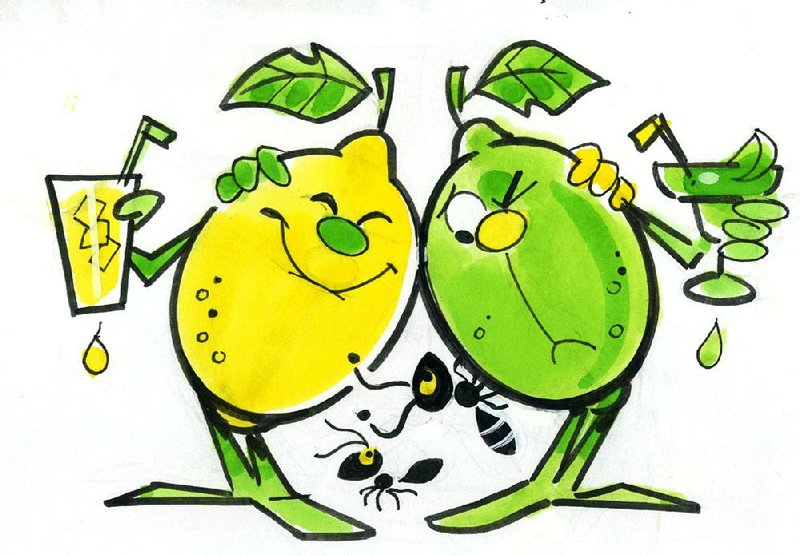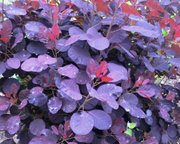Q This is my Meyer lemon tree or a lime tree. These places on the stem seem to attract ants in huge numbers. These are squashy, moldy looking things that do not move. I have wiped off a lot of this and sprayed the plant with water to get rid of quite a bit. I have sprayed the leaves with neem oil and sprinkled ant killer in the soil. Is there anything else I can do to get rid of this? The tree seems to be healthy.
A You have an extremely healthy case of scale insects. They are sucking sap out of the plant and giving off a sweet substance called honeydew, which ants adore. I am surprised the tree is still healthy with as many insects as you have. The neem oil should help. You can also spray with a summer-weight oil product -- directing it to the stems. But you need to do it before it gets too hot, as the oil can burn foliage when temperatures are high. Systemic insecticides do a good job, but not many are labeled for use on edibles. I would continue to monitor the scale. If you find it on limbs closer to the ends of branches, you could prune it out, but the picture you have sent has it pretty much all over.
Q I saw this red bush, which has fluffy red poofs at the end of the branches. Do you know what it is? [The reader supplied a photo.]
A The plant in question is a purple smoke tree (Cotinus). It can be grown as a large bush or a small tree. They have been quite showy this spring. There are green-leafed forms but, by far, the purple-foliaged plant is the more dramatic in the garden.
Q My son has an orange fungus or something on the mulch in his flower bed. Some mornings, he says, it has spread across most of the bed. If water is poured on it, a "smoke" goes up. Do you know what this is?
A We have seen a lot of slime mold this year with all the rain and humidity. It can come in a lot of colors, including orange, yellow, green and even blue. The "smoke" that you see coming off of it is the fungal spores. These fungi feed on decaying organic matter, bacteria and yeasts, so they can be common on mulch during warm, wet conditions. Thankfully, they look worse than they are. Just hose it down or use a rake to turn the mulch. When it dries out, they won't be around.
Q My aunt's Knock Out roses have diseased-looking leaves and I can't find a specific online match. Can I send you photos for a diagnosis?
A If you have plants that seem to be diseased, take a sample to your local county extension office. The best days of the week to take in samples are Monday and Tuesday so that the samples can get to the lab quickly without lingering in the mail over a hot weekend. If the local agent can't identify the problem, the agent will send it to our disease diagnostic lab in Fayetteville. Once the plant pathologist has determined the problem, you will get an email with a diagnosis and control method. This is (currently) a free service.
Q I live in White Hall and I have two questions to ask you. First, I have Confederate jasmine on a trellis that has filled in and covers the trellis perfectly and is loaded with blooms. My question is: Should I prune it, and if so, when? The only reason I would want to prune it is to contain its size for the trellis, or -- if needed -- to ensure blooming in the future. Second question: I am putting up another trellis (in a flower bed with southern exposure) and would like another evergreen vine. I saw a "Pretty Crimson" (a Sun Parasol mandevilla hybrid) and fell in love with it. Being more of a tropical vine, will this survive our winters if planted in the ground? If not, any suggestions as to what I can plant? I prefer to have a vine on the trellis throughout the year.
A I love Confederate jasmine (Trachelospermum jasminoides) which is neither Confederate nor a true jasmine. It is a great evergreen vine with some of the most fragrant blooms. It typically is covered in flowers from late April through early June and can have some sporadic flowers off and on during the summer. Since it is a prolific vine, pruning may be needed to keep it in check. Do so, as needed, when the main flowers have faded. Mandevillas come in a wide range of colors, but none of them would overwinter outdoors regardless. Carolina jasmine (Gelsemium sempervirens) is another evergreen vine with beautiful yellow flowers in the spring. An evergreen clematis -- Armand clematis -- has lovely white flowers in the spring, and there are many deciduous clematis you could mix in that have huge, showy flowers in a wide array of colors.
Janet B. Carson is a horticulture specialist for the University of Arkansas Cooperative Extension Service. Write to her at 2301 S. University Ave., Little Rock, Ark. 72204 or email her at
jcarson@arkansasonline.com
HomeStyle on 06/11/2016

